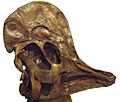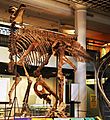Corythosaurus facts for kids
Quick facts for kids CorythosaurusTemporal range: Upper Cretaceous
|
|
|---|---|
 |
|
| Corythosaurus casuarius | |
| Scientific classification | |
| Kingdom: | |
| Class: | |
| Subclass: | |
| Superorder: | |
| Order: | |
| Family: | |
| Subfamily: | |
| Genus: |
Corythosaurus
Brown, 1914
|
Corythosaurus was a type of dinosaur that lived a long time ago. Its name means "helmet lizard." This is because of the cool, helmet-shaped crest on its head. It was a large plant-eating duck-billed dinosaur.
Corythosaurus was about 30–33 feet (9–10 meters) long. That's like two cars parked end-to-end! It stood about 6.6 feet (2 meters) tall at its hips. This dinosaur weighed around 3 to 5 tons. That's as heavy as a big truck!
Contents
Meet Corythosaurus: The Helmet Lizard
Corythosaurus was a special kind of dinosaur. It belonged to a group called hadrosaurs. These dinosaurs are famous for their unique "duck bills." They also had a hollow, bony crest on their heads.
What Did Its Crest Do?
The crest on top of Corythosaurus's head looked like a helmet. It was flattened on the sides. Scientists think this crest had two main jobs. First, it helped the dinosaur make loud sounds. Imagine a giant horn! Second, it helped different Corythosaurus recognize each other.
Male Corythosaurus likely had bigger crests. Females and younger dinosaurs had smaller ones. This might have helped them tell boys from girls. It also helped them know who was older.
How Did It Move?
Like other hadrosaurs, Corythosaurus could walk in two ways. It could move on two legs, like a human. It could also walk on all four legs, like a dog. We know this from dinosaur footprints found by scientists.
Corythosaurus had a long tail. This tail was stiff because of bony tendons inside it. These tendons kept the tail from dragging on the ground.
Its Hands and Feet
Corythosaurus's hands were interesting. They had four fingers. The first finger, like our thumb, was missing. The second, third, and fourth fingers were grouped together. They had hooves, like a horse. This suggests Corythosaurus might have used its hands for support when walking on all fours.
The fifth finger was free. This means it could move separately. It might have been used to grab or hold things. Each foot of Corythosaurus had only three toes.
Images for kids
-
ROM 845, mounted skeleton of Corythosaurus cf. intermedius cf. excavatus Parks 1935 at the Royal Ontario Museum
-
Skeleton at AMNH
-
Mounted skeleton at the Academy of Natural Science, Drexel University, Philadelphia
-
Skeleton from Dinosaur Provincial Park
See also
 In Spanish: Corythosaurus para niños
In Spanish: Corythosaurus para niños















